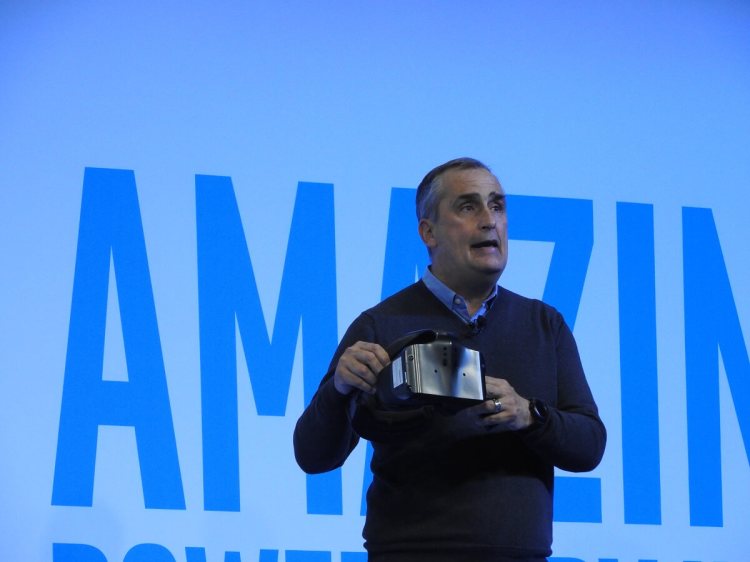Intel CEO Brian Krzanich said that 2016 was a transformational year for the company on a variety of fronts. Intel cut its staff, absorbed its Altera acquisition, and closed the year with strong sales in the data center, PC, and Internet of Things markets, Krzanich said in a conference call with analysts.
Client computing sales, which include processors for desktops and laptops, had strong execution and higher average selling prices (up 7 percent from a year ago) as customers opted for more gaming computers and high-end PCs, Krzanich said. During the quarter, Intel saw that the worldwide PC supply chain remained healthy and had inventory get used during the three months, said chief financial officer Bob Swan.
“Q4 was a strong finish to a record year,” Krzanich said.
In the data center, growth was good. Cloud service provider revenue was up 24 percent, and communications service provider revenue grew 19 percent. Internet of Things revenue was also strong. Krzanich was optimistic that data growth would continue to skyrocket, creating demand for Intel’s processors. He said that a connected car could generate 4,000 gigabytes of data per day.
He noted that the company has good design wins in connected cars with BMW, Baidu, and Delphi. In artificial intelligence, Krzanich said Intel processors are used in more than 90 percent of machine learning applications.
Of course, there’s pressure on Intel from competitors, and the PC continues to lose ground to other devices in the era of the smartphone. Intel dropped out of mobile processors, but it is still competitive in wireless data 4G and Wi-Fi chips, and it is positioning to be a player in 5G. Intel’s investment in 14-nanometer cost improves drove costs down 30 percent in the client computing business.
The world’s biggest chip maker reported fourth-quarter earnings that were mixed, missing its target on earnings per share but beating estimates for revenues. The results were driven by revenues from desktop and laptop computer chips, data center chips, and the Internet of Things. The latter was up 15 percent for the full year.
Analysts had expected Intel to report earnings per share of 75 cents on revenue of $15.8 billion for the fourth quarter. For the full year, they were expected earnings per share of $2.67 on revenue of $58.9 billion. Q4 earnings came in at $3.6 billion, or 73 a share, on revenue of $16.4 billion. A year ago, earnings per share were 74 cents, with revenue at $14.9 billion.
Intel stock rose 2 percent to $38.32 a share in after-hours trading, and it has since dropped to $37.77 a share, up only 0.56 percent.
During the quarter, Intel shipped more of its code-named Kaby Lake processors for computer makers showing off systems based on the chip at CES 2017, the big tech trade show in Las Vegas in the first week of January. Enterprise and government business was weaker in the quarter.
Advanced Micro Devices is expecting to be more competitive against Intel in 2017 as it readies its new Zen processors for PCs, laptops, and servers.
“Intel had a pretty good quarter. Client computing revenue has not only flattened but actually saw some slight increases even though units declined,” said Patrick Moorhead, analyst at Moor Insights & Strategy. “I attribute this to customers embracing more premium PCs driven by commercial upgrades, gaming and VR. Datacenter got back on track and while it wasn’t double-digit growth, many customers are waiting for the latest Purley server chips to their big upgrades, so I think there’s pent-up demand. Memory hit a home run, driven by 3D [flash memory]. It was a good end to a solid 2016 where I saw Intel making big moves and investments for the next five years.”
Net income for the year was $10.3 billion, while overall revenue for the year was $59.4 billion. A year ago, net income was $11.3 billion on revenue of $55.4 billion. Intel cut about 12,000 jobs during the year as it restructured to get behind the company’s focused priorities. As part of that process, Intel is spinning out McAfee, formerly Intel Security, as a separate business that is half-owned by Intel.
Intel’s most profitable segment is the data center group that sells chips for servers, the computers that process transactions in huge data centers. Data center group revenue was $4.7 billion in Q4, up 8 percent. Internet of Things revenue was $726 million, up 16 percent. Client computing revenue was $9.1 billion, up 4 percent. Non-volatile memory revenue was $816 million, up 25 percent. Intel Security Group revenue was $550 million, up 7 percent. And programmable solutions were $420 million, with no comparison to the year before because of the 2016 Altera acquisition.
Krzanich said that Altera has a record pipeline for its programmable chips. Swan added that the outlook assumes a stable macroeconomic environment. Intel is more cautious about demand for chips in emerging markets like Russia, China, and Latin America.
For the full year, Intel expects 2017 to be flat in terms of revenue. Krzanich said the company is taking a conservative view of 2017 PC unit sales than other analysts, but he noted there was record demand for Intel PC chips in Q4. Unit sales for 2017 could decline in the mid-single digit percentages, Krzanich said. Intel is positioning itself to lower its costs during the coming year.
“What we focus on in that market is how do you make money, how do you sell up?” Krzanich said.
VentureBeat's mission is to be a digital town square for technical decision-makers to gain knowledge about transformative enterprise technology and transact. Learn More

